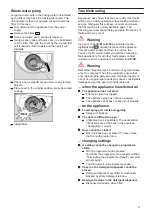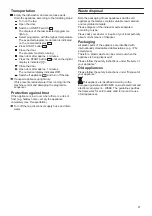
8
Utensils
Not suitable
Cutlery and utensils made of wood.
Delicate decorative glasses, craft and antique
utensils. These decors are not dishwasher-proof.
Plastic parts not resistant to heat.
Copper and tin utensils.
Utensils which are soiled with ash, wax, lubricating
grease or ink.
Aluminium and silver parts have a tendency to
discolour and fade during the wash cycle. Even some
types of glass (e.g. crystal glass objects) may turn
cloudy after many wash cycles.
Glass and utensil damage
Causes:
Glass type and glass production process.
Chemical composition of the detergent.
Water temperature of the wash programme.
Recommendation:
Use only glasses and porcelain which the
manufacturer designates as dishwasher-proof.
Use a detergent which protects utensils.
Take glass and cutlery out of the dishwasher as soon
as possible after the programme ends.
Loading the dishwasher
Remove large food remnants.
It is not necessary to prerinse utensils under running
water.
Place the utensils so that
D
they are secure and cannot tip over.
D
all utensils with their openings face down.
D
parts with curves or indentations are at an angle,
thereby allowing water to drain.
D
does not obstruct rotation of the two spray arms
23
and
27
.
Very small utensils should not be washed in the
machine, as they may fall out of the baskets.
Unloading the dishwasher
To prevent water from dripping off the upper basket
onto the utensils in the lower basket, it is
recommended to empty the appliance from the bottom
up.
Cups and glasses
Top basket
21
* depending on model
Pans
Bottom basket
31
Cutlery basket
You should always place cutlery unsorted with the
points downwards.
To prevent injuries, place long, pointed implements and
knives on the knife shelf.
Summary of Contents for DI 460-131
Page 2: ......
Page 22: ...22 en Subjekt to modification ...























